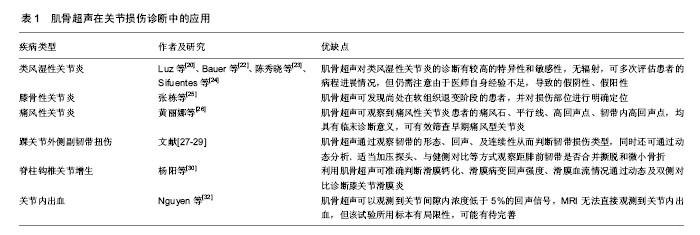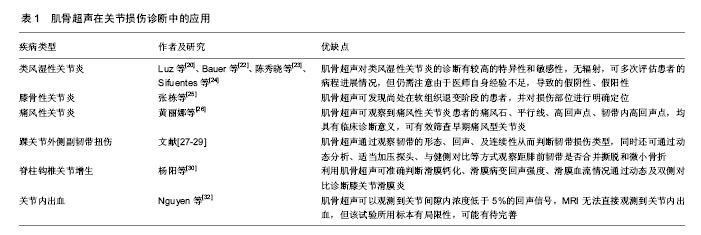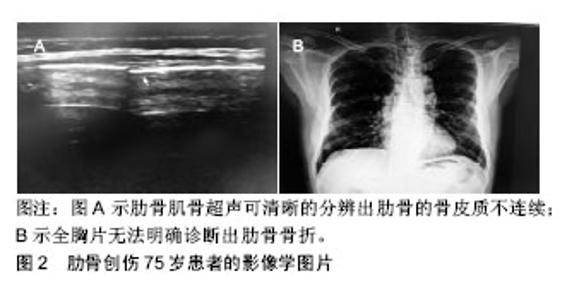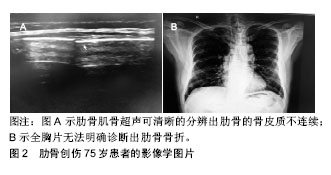Chinese Journal of Tissue Engineering Research ›› 2019, Vol. 23 ›› Issue (16): 2573-2578.doi: 10.3969/j.issn.2095-4344.1167
Previous Articles Next Articles
Application status and mechanism of musculoskeletal ultrasound in orthopedic diagnosis
Zhou Xuetian1, Ma Yong2, 3, Guo Yang3, Si Yuhao3, Zong Yonggang1, Zhong Chao1
- 1Medical College of Yangzhou University, Yangzhou 225001, Jiangsu Province, China; 2Department of Orthopedics, Yangzhou Municipal Hospital of Traditional Chinese Medicine, Yangzhou 225009, Jiangsu Province, China; 3Nanjing University of Chinese Medicine, Nanjing 210023, Jiangsu Province, China
-
Online:2019-06-08Published:2019-06-08 -
Contact:Ma Yong, Professor, Chief physician, Doctoral supervisor, Department of Orthopedics, Yangzhou Municipal Hospital of Traditional Chinese Medicine, Yangzhou 225009, Jiangsu Province, China; Nanjing University of Chinese Medicine, Nanjing 210023, Jiangsu Province, China -
About author:Zhou Xuetian, Master candidate, Medical College of Yangzhou University, Yangzhou 225001, Jiangsu Province, China -
Supported by:the National Natural Science Foundation of China (General Program), No. 81673995 (to MY)| the Natural Science Foundation for the Youth of Jiangsu Province, No. BK20151007 (to GY)
CLC Number:
Cite this article
Zhou Xuetian, Ma Yong, Guo Yang, Si Yuhao, Zong Yonggang, Zhong Chao. Application status and mechanism of musculoskeletal ultrasound in orthopedic diagnosis [J]. Chinese Journal of Tissue Engineering Research, 2019, 23(16): 2573-2578.
share this article

2.1 在肌肉与肌腱损伤诊断中的应用 肌肉的结构可清晰地通过高频超声显现,在声像图上其纹理由纤维脂肪间隔的高回声和肌实质的低回声构成。通过它可用于评估一系列肌肉病变,包括拉伤、撕裂伤、肌炎、皮下血肿、筋膜室综合征、肌疝等[5]。Todorov等[6]利用肌骨超声对梨状肌综合征患者和正常人的梨状肌厚度进行对比,发现患侧梨状肌低回声区明显大于健侧。上述观点,在后续学者的临床报道中得到了再次论证[7-8]。此外,Todorov等[6]还发现患侧梨状肌在动态扫描中存在不平滑的运动,且出现了梨状肌肌肉下缘和髂骨之间的距离减小。2位学者的临床研究中,均提示在对梨状肌进行肌骨超声检查时,若患侧肌肉厚度高于健侧,则考虑诊断为梨状肌综合征。针对Todorov等[6]提出的患侧梨状肌存在的不平滑运动及梨状肌撞击迹象,可在今后此类患者的超声动态分析中进一步探究。 Watanabe等[9]利用肌骨超声评估志愿者的股四头肌的厚度、偏斜度、峰度、逆差力矩、角秒、肌肉强度时,发现肌肉质量随年龄增长显著降低。他认为肌骨超声可定量评估因老化引起的肌肉形态学变化,但作者认为该试验在临床应用中较为受限,可能在评估早期的肌肉损伤方面不如MRI。Xiao等[10]应用肌骨超声检测慢性足底筋膜炎患者,发现患侧足底筋膜厚度明显大于健侧,可评估水肿的严重程度,为慢性足底筋膜炎的诊断提供参考。Longo等[11]对延迟性肌肉酸痛的患者肌肉的超声表现进行回顾性分析,发现其超声最常见的阳性表现为肌肉增大、边界清晰、弥漫分布,肌肉基本无充血。目前MRI在诊断该疾病时敏感性差,可进一步研究该疾病在超声下的特异性表现。 虽然诊断肩袖撕裂时通常依靠MRI判断分型及周围软组织异常,但该疾病在肌骨超声下也可观察到肌腱和肌肉的异常。Langen等[12]曾报道在专业医师的超声检查下MRI和肌骨超声在诊断肩袖撕裂时诊断率基本吻合。Tamborrini等[13]随后的大样本临床观察也证实了这个观点。Lee等[14]在研究肩袖撕裂的术后并发症时,发现肌骨超声能够敏锐发现术后肌腱厚度改变以此判断肌腱有无再次撕裂。肌骨超声可在诊断肩袖撕裂时作为辅助检查,相较MRI更加省时省力,并弥补它无法动态观察的不足。 在研究跟腱损伤慢性发病原因时,通过肌骨超声发现肌腱异常与跟腱的未来风险呈正相关,跟腱运动时区域肌腱变形不一致,可量化分析跟腱未来病变[15-16]。Ooi等[17]在研究跟腱损伤患者时,发现肌骨超声具有较高的确诊率,并在观察肌腱纤维的增厚、钙化方面更为优秀,能够有效判断跟腱钙化位置,为以后的治疗提供临床依据。肌骨超声可发现骨折术后患者不同程度的肌腱损伤[18]。虽然此类报道相关文献较少,可能需大样本的临床病例进一步观察,但对于术后疼痛,作者认为预防肌腱损伤这类并发症尤为重要,可利用肌骨超声分辨率高、可重复动态观察等优点,将其作为观察术后肌腱情况的主要手段。 2.2 在关节损伤诊断中的应用 肌骨超声在关节疾病诊治中的重要作用已被临床广泛接受和认可,EULAR/ACR最新指南中将肌骨超声推荐作为类风湿性关节炎诊断和疗效评估的影像学手段[19]。Luz等[20]利用肌骨超声检查早期类风湿性关节炎患者时,发现初诊时28个关节疾病活动评分与能量多普勒和腱鞘炎均显著相关,在随访期间28个关节疾病活动评分与骨侵蚀和腱鞘炎也均有显著的相关性。肌骨超声技术是早期检测类风湿性关节炎患者疾病活动和功能状态的纵向变化的有效临床手段,它对早期类风湿性关节炎的敏感性优于MRI。马艳等[21]利用高频超声研究该病在双手关节早期病变时得出相似结论。Bauer等[22]将类风湿患者按照体质量指数分成3组进行超声成像,发现关节肿胀的阳性检测率与体质量指数呈负相关。故诊断体质量较大的类风湿性关节炎患者时,查体时的关节肿胀需通过肌骨超声来确定。陈秀晓等[23]在类风湿性关节炎与正常人比较的临床报道中,通过肌骨超声发现两者软骨厚度、关节积液及滑膜厚度均有明显差异。Sifuentes-Cantu等[24]将类风湿性关节炎患者分别由专家和培训医师进行超声评估,发现专家组较培训医师组诊疗具有更好的相关性。肌骨超声技术在诊断类风湿性关节炎时,医师的影响也不可忽略。以上研究均提示肌骨超声技术对类风湿性关节炎的诊断有较高的特异性和敏感性,其具有无辐射的特点,可多次评估类风湿性关节炎患者的病程进展情况,但仍需注意由于医师自身经验不足导致的假阴性、假阳性。 对于其他各类关节炎,肌骨超声也体现了诊断初期病变时的优势。张栋等[25]将膝骨性关节炎患者的肌骨超声成像和X射线片的表现进行比较,发现大量症状典型的膝骨性关节炎患者,在X射线上表现并不明显,而通过肌骨超声可发现尚处在软组织退变阶段的患者,并对损伤部位进行明确定位,更好的为患者的治疗方案提供诊断依据。黄丽娜[26]在研究痛风性关节炎时,发现肌骨超声可观察到痛风性关节炎患者的痛风石、平行线、高回声点、韧带内高回声点,均具有临床诊断意义,可有效筛查早期痛风型关节炎。 在诊断踝关节外侧副韧带扭伤的患者时,肌骨超声通过观察韧带的形态、回声、及连续性从而判断韧带损伤类型[27-28],同时还可通过动态分析、适当加压探头、与健侧对比等方式观察距腓前韧带是否合并撕脱和微小骨折[29]。肌骨超声在诊断此类疾病时,与MRI无明显差异,且更便捷廉价、易于操作,值得在临床推广。 杨阳等[30]在研究脊柱钩椎关节增生时,发现肌骨超声的确诊率与CT、血管造影无明显差异,但其相对更方便廉价。膝关节滑膜炎的诊断常存在误区,利用肌骨超声可准确判断滑膜钙化、滑膜病变回声强度、滑膜血流情况通过动态及双侧对比诊断膝关节滑膜炎[31]。学者 Nguyen等[32]在研究关节内出血时,发现肌骨超声可以观测到关节间隙内浓度低于5%的回声信号,MRI无法直接观测到关节内出血,但该试验所用标本有局限性,可能有待完善,需通过更多的临床试验来确定肌骨超声对关节内出血的敏感性。 肌骨超声技术在诊断关节疾病时,相比MRI可更早发现类风湿性关节炎、膝骨性关节炎、痛风性关节炎,有助于控制病情的发展,及时保护关节功能。在诊断踝关节外侧副韧带扭伤、关节内增生、膝关节滑膜炎时相对CT、MRI等手段更具优势,并为关节内出血提供了新的诊断方法,见表1。"


2.3 在骨与软骨损伤诊断中的应用 肌骨超声在骨与软骨成像方面,通过高分辨率提示骨皮质细微改变和软骨表面、厚度、完整性等信息,可发现X射线、CT、MRI等未发现的问题。在诊断急诊创伤骨折时,往往因场地因素延误救治,或因搬运不当造成2次损伤,肌骨超声在诊断急诊创伤骨折时与X射线无明显差异,且可动态观察骨折复位情况,有效减少伤口至诊断及复位的时间间隔,缓解了肢体肿胀情况,减少了出血量[33]。然而,椎体骨折仅靠声像图难以准确诊断,仍需依靠CT为手术方案的选择提供依据。Lau等[34]通过肌骨超声发现桡骨远端骨折复位前后均具有较高的灵敏性和特异度,与MRI无明显差异。但肌骨超声可动态观察复位前后情况,确保复位准确。Mure?an等[35]利用肌骨超声和MRI观察运动员内外侧半月板,发现两者灵敏度和特异性没有显著差异。肌骨超声技术相对MRI更简便快捷、省时省力值得在检查运动员半月板受损时推广,并可选取更多研究对象进一步分析。 平片往往无法发现隐匿性骨折,但肌骨超声的高分辨率可通过回声异常检查出该类疾病,见图2。有关于右胸部钝伤致肋软骨骨折的临床个案报道,初诊胸片无异常,1周后通过肌骨超声发现右侧第10肋软骨移位骨折,在随后的超声检查中证实骨折愈合[36]。在诊断肋骨骨折时,肌骨超声对于受力较小、骨折移位较小的微小骨折优于X射线,同时还可观察血气胸及肺损伤等相关并发症的变化情况[37]。Maeda等[38]关于儿童侧踝韧带软骨撕脱骨折的研究也得出相似的结论,他利用肌骨超声发现软骨损伤周围存在高回声点,而这些患者在平片诊断时均无法完全判断损伤情况。对于隐匿性的软骨骨折,肌骨超声可提供临床依据。 疲劳性骨折是由于长期阈下应力作用于骨骼,导致局部骨小梁不断受损最终发生骨折,病情早期X射线较难发现,CT、MRI虽有较高灵敏度,但价格昂贵,且疲劳性骨折早期多无明显症状,不易重视,无法将MRI作为该病的常规检查。肌骨超声可通过骨痂变化和血流灌注情况,作为该病筛查、检测的常规检查[39]。"


肌骨超声在诊断骨与软骨损伤时,因其便捷,易于携带操作的特点,可用于急诊创伤骨折;动态分析观察使其能够观察骨折复位前后情况,确保复位成功;另外肌骨超声的高分辨率可用于诊断隐匿性骨折和疲劳性骨折,避免漏诊。 2.4 在神经损伤诊断中的应用 目前腰丛、臂丛、坐骨神经等粗大神经临床多使用MRI直接观察,且效果理想。但对于外周神经损伤,MRI往往无法识别,导致骨科手术中造成的神经损伤无法及时诊治。Connor等[40]报道了1例尺骨半脱位术后疼痛未改善的患者,在MRI检查无异常的情况下,肌骨超声未在肱三头肌内侧头下发现尺神经,随后证实尺神经移位。此类案例启发评估术后神经损伤时,动态肌骨超声优于MRI和体格检查。王战业等[41]在利用肌骨超声研究外周神经医源性损伤时,也得出相似的结论。古旸等[42]在使用肌骨超声观察肱骨干骨折切开复位内固定术后患者时,再次论证了上述观点。故术后出现外周神经疼痛时,对其进行肌骨超声动态分析尤为重要。 张玉玲[43]将肌骨超声用于诊断桡神经损伤,依据高频超声成像特点对肱骨骨折后并发桡神经损伤的患者制定治疗方案,患者预后良好,该作者认为高频超声检测可提供神经损伤部位、程度及类型,且能提供损伤神经周边组织情况,与手术探查结果符合率高,有利于早期做出诊断,为正确治疗提供依据。郭云怀等[44]探究高频超声在外周损伤的价值时,得出相似结论,其研究中虽然存在2例误诊,但肌骨超声仍可在临床上解决MRI仅适用于腰丛、臂丛等较粗大神经的问题,同时误诊的原因可能与医师自身经验和病患的特异性有关。肌骨超声能提供骨科术前患者的神经受损情况,帮助制定手术方案,可在临床推广。"

| [1] McDonald DG, Leopold GR. Ultrasound B-scanning in the differentiation of Baker's cyst and thrombophlebitis. Br J Radiol. 1972;45(538):729-732.[2] 张光,马千里,李先海. 影像学诊断与技术[M]. 哈尔滨:黑龙江科学技术出版社, 1900.[3] 王智勇,钟秀,张云凤. 医学影像学在临床骨科中的应用进展[J]. 中国卫生产业, 2016,13(27):196-198.[4] 张文静,刘志成,高玉,等. 基于肌骨超声技术评价循经筋阿是穴治疗膝骨性关节炎的临床疗效观察[J]. 世界中西医结合杂志, 2014,9(8):834-836.[5] 吴筱辉. 超声在肌肉肌腱及软组织检查中的应用[J]. 浙江临床医学, 2001,3(4):298.[6] Todorov PT. Ultrasonographic study of the piriformis muscle and sonographic features of the piriformis syndrome in chronic low back pain. Ann Rheum Dis. 2014;Suppl 2(73): 303-304.[7] 贺亭. 梨状肌综合征的超声诊断探讨[D]. 南宁:广西医科大学, 2016.[8] 赵俊,韩龄锋. 梨状肌综合征的超声表现分析[J]. 中国中西医结合影像学杂志, 2018,16(1):89-91.[9] Watanabe T, Murakami H, Fukuoka D, et al. Quantitative Sonographic Assessment of the Quadriceps Femoris Muscle in Healthy Japanese Adults. J Ultrasound Med. 2017;36(7): 1383-1395.[10] Xiao YT, Function DO. Diagnostic value of musculoskeletal ultrasonography in chronic plantar fasciitis. Hainan Med J. 2017.[11] Longo V, Jacobson JA, Fessell DP, et al. Ultrasound Findings of Delayed-Onset Muscle Soreness. J Ultrasound Med. 2016; 35(11):2517-2521.[12] Langen E, Lee H, Park M, et al. Diagnositic utility of ultrasound and MRI in women with placenta previa and placental invasion. Am J Obst Gynecol. 2011;204(1):S137.[13] Tamborrini G, Marx C, Micheroli R. FRI0588 3D VS 2D musculoskeletal ultrasound of supraspinate tendon tears. Ann Rheum Dis. 2015;2(74):640-641.[14] Lee SC, Williams D, Endo Y. The Repaired rotator cuff: mri and ultrasound evaluation. Curr Rev Musculoskelet Med, 2018;11(1):92-101.[15] Bogaerts S, De Brito CC, Scheys L, et al. Evaluation of tissue displacement and regional strain in the Achilles tendon using quantitative high-frequency ultrasound. PLoS One. 2017; 12(7):e181364.[16] McAuliffe S, McCreesh K, Culloty F, et al. Can ultrasound imaging predict the development of Achilles and patellar tendinopathy? A systematic review and meta-analysis. Br J Sports Med. 2016;50(24):1516-1523.[17] Ooi CC, Schneider ME, Malliaras P, et al. Diagnostic performance of axial-strain sonoelastography in confirming clinically diagnosed Achilles tendinopathy: comparison with B-mode ultrasound and color Doppler imaging. Ultrasound Med Biol. 2015;41(1):15-25.[18] Morgan TA, Piper SL, Lattanza LL, et al. Distal forearm fracture open reduction-internal fixation: sonographic detection of hardware malalignment and associated tendon injuries missed by radiography. J Ultrasound Med.2017; 36(10):2173-2177.[19] Ohrndorf S, Backhaus M. Musculoskeletal ultrasonography in patients with rheumatoid arthritis. Nat Rev Rheumatol. 2013; 9(7):433-437.[20] Luz KR, Pinheiro MM, Petterle GS, et al. A new musculoskeletal ultrasound scoring system (US10) of the hands and wrist joints for evaluation of early rheumatoid arthritis patients. Rev Bras Reumatol Engl Ed. 2016;56(5): 421-431.[21] 马艳,金莉,李向培,等. 高频超声在类风湿关节炎双手关节病变的应用价值[J]. 实用医学杂志, 2016,32(11):1810-1812.[22] Bauer EM, Ben-Artzi A, Duffy EL, et al. Joint-specific assessment of swelling and power Doppler in obese rheumatoid arthritis patients. BMC Musculoskelet Disord. 2017;18(1):99.[23] 陈秀晓,吴圆圆,隋文倩. 肌骨超声在类风湿关节炎评估中的应用价值分析[J]. 中国继续医学教育, 2017,9(19):64-65.[24] Sifuentes-Cantu C, Contreras-Yanez I, Saldarriaga L, et al. The added value of musculoskeletal ultrasound to clinical evaluation in the treatment decision of rheumatoid arthritis outpatients: physician experience matters. BMC Musculoskelet Disord. 2017;18(1):390.[25] 张栋,王庆甫,石鑫超,等. 膝骨关节炎肌骨超声与X线片表现的比较与分析[J]. 中国骨伤, 2016,29(5):429-433.[26] 黄丽娜. 痛风性关节炎患者的肌肉骨骼超声表现及其临床诊断价值[J]. 包头医学院学报, 2017,33(6):40-42.[27] 肖岚,李素淑. 高频超声诊断急性踝内翻外侧副韧带损伤的临床价值[J]. 中国医疗设备, 2016,31(6):62-64.[28] 陈征,李建国,陈思,等. 急性踝内翻扭伤的超声检查和诊断探讨[J]. 中国超声医学杂志, 2014,30(10):933-936.[29] 黄丹,何秀珍,杨旭欢,等. 高频超声分层诊断踝关节外侧副韧带3种损伤类型的价值:前瞻性,单中心,诊断性试验方案及预试验结果[J]. 中国组织工程研究, 2018,22(23):3681-3686.[30] 杨阳,张瑞,刘纯红. 肌骨超声评估颈椎钩椎关节增生的效度研究[J]. 中国社区医师, 2017,33(24):90-92.[31] 吴言,杜国庆,杜佩,等. 膝关节软骨及滑膜病变:超声诊断的常见误区与鉴别思路[J]. 中国组织工程研究, 2015,19(15): 2436-2441.[32] Nguyen S, Lu X, Ma Y, et al. Musculoskeletal ultrasound for intra-articular bleed detection: a highly sensitive imaging modality compared with conventional magnetic resonance imaging. J Thromb Haemost. 2018;16(3):490-499.[33] 赵丽,赵胜军,徐洪. 高频超声在急诊创伤骨折中诊断价值研究[J]. 临床军医杂志, 2018,46(7):759-762.[34] Lau BC, Robertson A, Motamedi D, et al. The validity and reliability of a pocket-sized ultrasound to diagnose distal radius fracture and assess quality of closed reduction. J Hand Surg Am. 2017;42(6):420-427.[35] Muresan S, Muresan M, Voidazan S, et al. The accuracy of musculoskeletal ultrasound examination for the exploration of meniscus injuries in athletes. J Sports Med Phys Fitness. 2017;57(5):589-594.[36] Bortolotto C, Federici E, Draghi F, et al. Sonographic diagnosis of a radiographically occult displaced fracture of a costal cartilage. J Clin Ultrasound. 2017;45(9):605-607.[37] 黄丽,高峰,罗庆华. 高频超声在急诊肋骨及肋软骨骨折中的临床应用[J]. 中国医学物理学杂志, 2018,35(1):106-109.[38] Maeda M, Maeda N, Takaoka T, et al. Sonographic Findings of Chondral Avulsion Fractures of the Lateral Ankle Ligaments in Children. J Ultrasound Med. 2017;36(2):421-432.[39] 宋升. 新兵胫骨应力性损伤的高频超声和MRI对照研究[D]. 南京:江苏大学, 2009.[40] Connor C, Weinik MM. Poster 221 the preoperative role of musculoskeletal ultrasound in evaluation for ulnar nerve transposition: a case report. PMR. 2014;9(6):S262-S263.[41] 王战业,曹洪弘,夏炳兰. 高频超声检查在外周神经医源性损伤诊断中的应用[J]. 现代医学, 2016,44(6):823-825.[42] 古旸,何芳,梁嘉樑,等. 高频超声对上肢骨折后出现周围神经损伤的诊断价值[J]. 临床超声医学杂志, 2016,18(12):855-856.[43] 张玉玲. 高频超声技术在桡神经损伤诊断中的应用价值[J]. 中国实用神经疾病杂志, 2017,20(9):91-93.[44] 郭云怀,高博,马力,等. 高频超声在外周神经损伤中的应用价值[J]. 医学影像学杂志, 2017,27(4):729-731. |
| [1] | Song Shan, Hu Fangyuan, Qiao Jun, Wang Jia, Zhang Shengxiao, Li Xiaofeng. An insight into biomarkers of osteoarthritis synovium based on bioinformatics [J]. Chinese Journal of Tissue Engineering Research, 2021, 25(5): 785-790. |
| [2] | Shi Xiaoxiu, Mao Shilong, Liu Yang, Ma Xingshuang, Luo Yanfeng. Comparison of tantalum and titanium (alloy) as orthopedic materials: physical and chemical indexes, antibacterial and osteogenic ability [J]. Chinese Journal of Tissue Engineering Research, 2021, 25(4): 593-599. |
| [3] | Cheng Chongjie, Yan Yan, Zhang Qidong, Guo Wanshou. Diagnostic value and accuracy of D-dimer in periprosthetic joint infection: a systematic review and meta-analysis [J]. Chinese Journal of Tissue Engineering Research, 2021, 25(24): 3921-3928. |
| [4] | Liu Zhiwei, Xie Rui, Sun Kai, Li Kaiming, Wang Xiongwei, Zhan Jiawen, Zhu Liguo. Interpretation of diagnostic criteria for cervicogenic headache: challenges and understandings in diagnosis and differential diagnosis [J]. Chinese Journal of Tissue Engineering Research, 2021, 25(23): 3746-3751. |
| [5] | Pan Xuan, Zhao Meng, Zhang Xiumei, Zhao Jie, Zhai Yunkai. Research and application of biological three-dimensional printing technology in the field of precision medicine: analysis of Chinese and English literature [J]. Chinese Journal of Tissue Engineering Research, 2021, 25(21): 3382-3389. |
| [6] | Cui Tiantian, Yi Lan, Ouyang Hougan, Wu Huiting, Ouyang Yanchu, Chen Chu. Effect of thermosensitive moxibustion in a rat model of pelvic inflammation based on trifocal focal membrane theory [J]. Chinese Journal of Tissue Engineering Research, 2021, 25(20): 3168-3172. |
| [7] | Jing Jinpeng, Zhang Yue, Liu Xiaomin, Liu Yi. Buyang Huanwu Decoction in prevention of deep venous thrombosis after orthopedic surgery: meta-analysis and trial sequential analysis [J]. Chinese Journal of Tissue Engineering Research, 2021, 25(20): 3267-3274. |
| [8] | Zhong Yuanming, Fu Xiaopeng, Xu Wei, Zhao Qingrui, Huang Yong, Ye Weiquan. Nicardipine controlled hypotension applied to perioperative blood loss in orthopedics: a meta-analysis [J]. Chinese Journal of Tissue Engineering Research, 2021, 25(18): 2930-2937. |
| [9] | Liu Zhengpeng, Wang Yahui, Ming Ying, Sun He. Computer design combined with three-dimensional printing template for spinal orthopedics can improve surgical accuracy and correction effect [J]. Chinese Journal of Tissue Engineering Research, 2021, 25(12): 1826-1830. |
| [10] | Zhou Chen, Xing Wenhua. Application advantages of three-dimensional printing technology and finite element analysis in scoliosis correction [J]. Chinese Journal of Tissue Engineering Research, 2021, 25(12): 1898-1903. |
| [11] | Wang Wencheng, Zhang Xingfei, Xu Yajun. Application of digital technology in the treatment of hallux valgus [J]. Chinese Journal of Tissue Engineering Research, 2021, 25(12): 1911-1916. |
| [12] | Zhang Yicen, Wang Peixin, Liu Zhicheng. Ultrasound-guided injection of hyaluronic acid and corticosteroid for treating plantar fasciitis: evaluation of pain, fascia thickness and ankle-foot function [J]. Chinese Journal of Tissue Engineering Research, 2021, 25(11): 1670-1674. |
| [13] | Yan Jiying. Mechanical simulation analysis of static finite element models of the femur with different material assignments [J]. Chinese Journal of Tissue Engineering Research, 2020, 24(9): 1390-1394. |
| [14] | Cao Xuhan, Bai Zixing, Sun Chengyi, Li Yanle, Sun Weidong. Application of robot in orthopedic surgery: reliability and room for improvement [J]. Chinese Journal of Tissue Engineering Research, 2020, 24(9): 1416-1421. |
| [15] |
Zhang Cong, Zhao Yan, Du Xiaoyu, Du Xinrui, Pang Tingjuan, Fu Yining, Zhang Hao, Zhang Buzhou, Li Xiaohe, Wang Lidong.
Biomechanical analysis of the lumbar spine and pelvis in adolescent
idiopathic scoliosis with lumbar major curve |
| Viewed | ||||||
|
Full text |
|
|||||
|
Abstract |
|
|||||